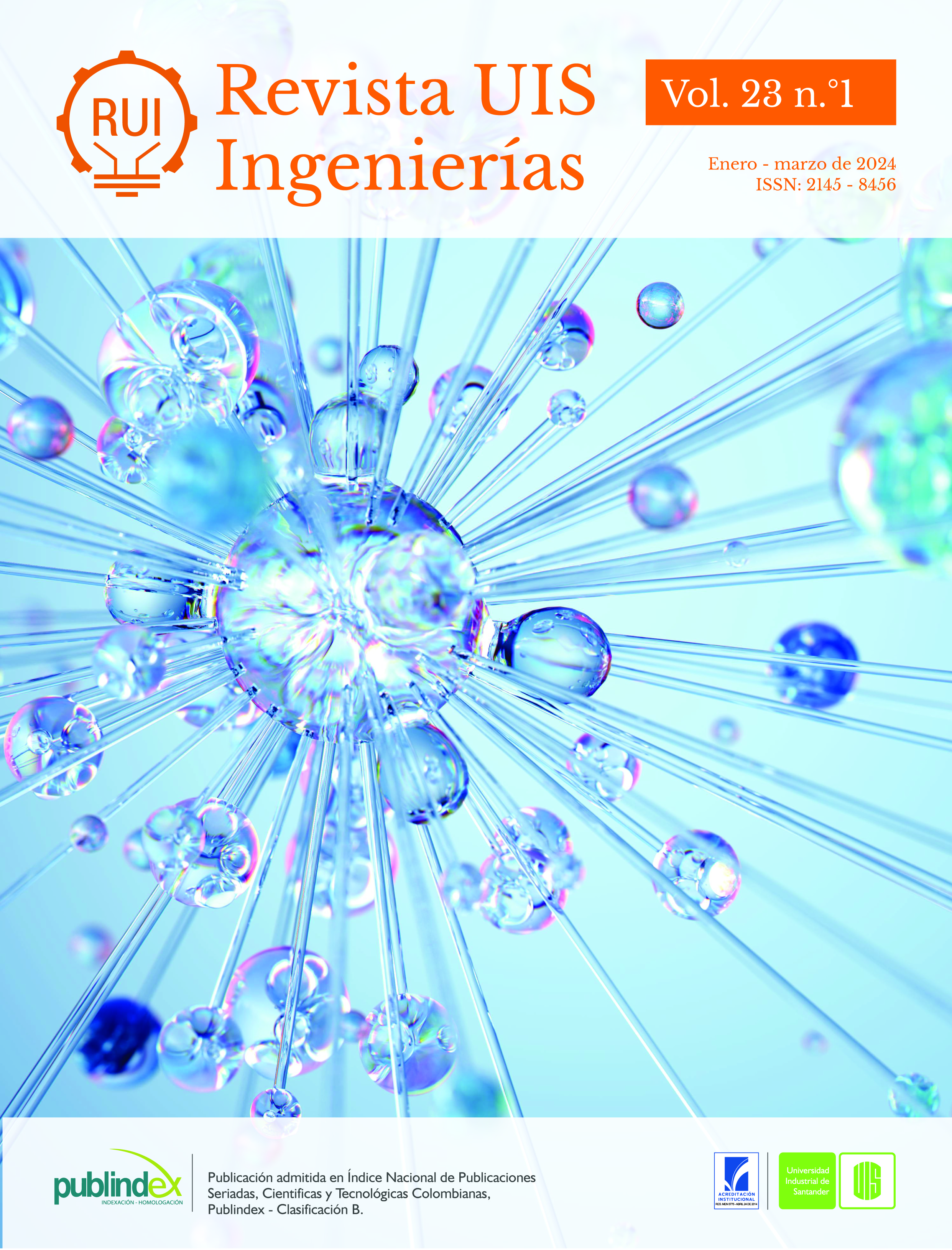Estudio experimental del comportamiento mecánico de tuberías enterradas sometidas a ciclos de carga térmica
Publicado 2024-04-12
Palabras clave
- estudio experimental,
- análisis de esfuerzos en tuberías,
- comportamiento mecánico,
- cargas térmicas,
- elementos finitos
- esfuerzos en tuberías,
- tuberías enterradas,
- ingeniería geotécnica,
- ingeniería de petróleo,
- modelado numérico ...Más
Cómo citar
Derechos de autor 2024 Revista UIS Ingenierías

Esta obra está bajo una licencia internacional Creative Commons Atribución-SinDerivadas 4.0.
Resumen
This paper presents an experimental study on the mechanical behavior of buried pipes subjected to thermal load cycles. Firstly, stresses and deformations are measured experimentally on a buried pipe subjected to monotonic and cyclic thermal loads, hence reproducing the typical operating conditions of buried piping systems. Subsequently, a numerical model is developed using the finite element method, which is validated using the results obtained experimentally. Subsequently, this computational model was used to carry out a parametric study of the influence of the mechanical properties of the soil on the stress state of the system. Finally, from the results obtained experimentally and numerically, it is concluded that the most critical situation in terms of stresses takes place when the pipe is firstly placed into operation, i.e. in the first cycle of thermal load and the other variables studied have little impact.
Descargas
Referencias
- R. Saadeldin, Y. Hu, A. Henni, “Numerical analysis of buried pipes under field geo-environmental conditions,” International Journal of Geo-Engineering, vol. 6, no. 1, p. 1-22, 2015, doi: https://doi.org/10.1186/s40703-015-0005-4
- D. Wijewickreme, “Role of geotechnical engineering in assuring the integrity of buried pipeline systems,” International conference on sustainable built environments. Kandy, Sri Lanka, 2012.
- M. M. Shahzamanian, M. Kainat, N. Yoosef-Ghodsi, S. Adeeb, “Systematic literature review of the application of extended finite element method in failure prediction of pipelines,” Journal of Pipeline Science and Engineering, vol. 1, no. 2, pp. 241-251, 2021, doi: https://doi.org/10.1016/j.jpse.2021.02.003
- J. Zhang, R. Xie, T. Zheng, G. Lu, J. Y. Xu, “Buckling behavior of buried pipe crossing stratum subsidence area”, Engineering Failure Analysis, vol. 135, 106130, 2022, doi: https://doi.org/10.1016/j.engfailanal.2022.106130
- American Society of Mechanical Engineers. ASME B 31.4. Pipeline Transportation Systems for Liquid Hydrocarbons and Other Liquids. 2013.
- American Society of Mechanical Engineers. ASME B 31.8. Gas Transmission and Distribution Piping Systems. 2013.
- L. Peng, “Stress analysis methods for underground pipe lines. Part 2,” Pipe Line Industry, pp. 65-75, 1978.
- L. Peng, “Stress Analysis Methods for Underground Pipe Lines. Part 1,” Pipe Line Industry, pp. 67-71, 1978.
- P. F. Liu, J. Y. Zheng, B. J. Zhang, P. Shi, “Failure analysis of natural gas buried X65 steel pipeline under deflection load using finite element method,” Materials and Design, vol. 31, no. 3, pp. 1384-1391, 2010, doi: https://doi.org/10.1016/j.matdes.2009.08.04
- Y. Friedmann, “Some Aspects of the Design of Hot Buried Pipelines,” in Offshore Oil and Gas Pipe Line Technology Conference, Paris, France, 1986.
- C. P. K. Gallage, J. Kodikara, D. Chan, “Response of a plastic pipe buried in expansive clay,” Proceedings of the Institution of Civil Engineers-Geotechnical Engineering, vol. 165, no. 1, pp. 45–57, 2011, doi: https://doi.org/10.1680/geng.9.00037
- Y. Hu, H. Q. Vu, “Analysis of soil conditions and pipe behaviour at a field site,” Canadian Geotechnical Journal, vol. 48, no. 6, pp. 847-866, 2011, doi: https://doi.org/10.1139/t11-010
- G. Kruisman, K. W. Radder, “Influence of the soil in advanced buried pipe line analysis,” in Offshore Oil and Gas Pipe Line Technology Conference, Ostend, 1990.
- Y. Friedmann, B. Debouvry, “Analytical design method helps prevent buried pipe upheaval,” Pipe Line Industry, pp. 23-27, 1992.
- N. J. R. Nielsen, B. Lyngberg, P. T. Pedersen, “Upheaval buckling failures of insulated buried pipelines: A case story,” in Offshore Technology Conference, Houston, Texas, paper OTC-6488-MS, 1990, doi: https://doi.org/10.4043/6488-MS
- P. E. L. Schaminee; N. F. Zorn; G. J. M. Schotman, “Soil response for pipeline upheaval buckling analyses: Full-scale laboratory tests and modelling,” in Offshore Technology Conference, Houston, Texas, paper OTC-6486-MS, 1990, doi: https://doi.org/10.4043/6486-MS
- J. A. Villarraga, J. F. Rodrı́guez, C. Martı́nez, “Buried pipe modeling with initial imperfections,” Journal of Pressure Vessel Technology, vol. 126, no. 2, pp. 250-257, 2004, doi: https://doi.org/10.1115/1.1688369
- FLOWTITE, “Installation Guide for Buried Pipes – AWWA,” 2016. [Online]. Available: https://www.flowtite.com/wp-content/uploads/1901_Flowtite-Installation-Guide-Buried-Pipes_web.pdf.
- American Society of Testing Materials. ASTM E 8M. Standard Test Methods for Tension Testing of Metallic Materials. 2004.
- W. F. Chen, Ed., “Chapter 1 - Introduction,” in Developments in Geotechnical Engineering, vol. 7, Supplement C vols., Elsevier, 1975, pp. 1–14.
- R. Colasanti, J. Hovarth, “Practical subgrade model for improved soil-structure interaction analysis: Software implementation,” Practice periodical on structural design and construction, vol. 15, no. 4, 2010, doi: https://doi.org/10.1061/(ASCE)SC.1943-5576.0000060
- R. Goncalves, Introducción al Análisis de Esfuerzos. Caracas: Editorial Equinoccio, 2011.
- L. Espinoza, O.A. González-Estrada, C. Graciano, “Análisis de un interno tipo brida de un recipiente horizontal a presión utilizando elementos finitos”, Revista UIS Ingenierías, vol. 18, no. 3, pp. 151-156, 2019, doi: https://doi.org/10.18273/revuin.v18n3-2019015
- E. Araque, C. Graciano, D.G. Zapata-Medina, O.A. González-Estrada, “Compressive strength of partially stiffened cylinders at elevated temperatures,” Revista UIS Ingenierías, vol. 19, no. 1, pp. 131-142, 2020, doi: https://doi.org/10.18273/revuin.v19n1-2020013
- C. Graciano, E. Casanova. “Modelado numérico del proceso de izado de un cabezal hemisférico de un regenerador,” Revista UIS Ingenierías, vol. 21, no. 3, pp. 101-110, 2022, doi: https://doi.org/10.18273/revuin.v21n3-2022009
- ANSYS, “ANSYS Release 19R2 Elements Reference”, 2019.
- T. W. Lambe, R. V. Whitman, Soil Mechanics Si Version. Wiley India Pvt. Limited, 2008.
- P. Hudak, B. Sadler, B. Hunter, “Analyzing underground water-pipe breaks in residual soils,” Water Engineering Management, vol. 145, pp. 15–20, 2000.

